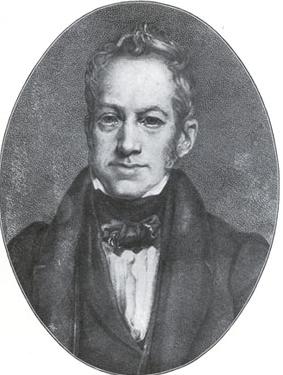Some Biogeographers, Evolutionists and Ecologists:
Chrono-Biographical Sketches
Brown, Robert (Scotland 1773-1858)
botany
 |
Like many naturalists-to-be of his time, Brown's early adult years were taken up by medical studies; during his late twenties he was mainly occupied as a surgeon in the military. Happily, in 1800 an opportunity presented itself to join the Matthew Flinders exploration expedition on the ship Investigator, and for the next five years Brown found himself in Australasian lands collecting botanical specimens. On returning to Britain he then spent another five years consumed in their study, after which he came into the employ of Sir Joseph Banks as a curator and assistant. When Banks died in 1820, he left Brown his residence, an annuity, and his botanical collection--which, also by plan, Brown donated to the British Museum, working out an agreement whereby he could remain its permanent keeper. But as he aged Brown's interest in descriptive work on botanical collections waned; even his four-part Plantę Javanicę Rariores represented little more than an abstract of what might have been. The inheritance from Banks kept Brown from having to teach or take on other duties, so he let his personal interests be his guide. Microscopy, still in its early years, was primary among these, and in fact his great skill at this persuasion ultimately garnered him his two most famous discoveries: the so-called "Brownian motion" of microparticles in liquids, and the characteristics of the nucleus of plant cells. |
Life Chronology
--born in Montrose, Tayside, Scotland, on 21 December 1773.
--1791: reads paper before the Edinburgh Natural History Society
--1793: earns medical degree from Edinburgh University
--1795-1800: surgeon's mate with the Fifeshire Regiment of Fencibles
in Ireland
--1801-1805: naturalist attached to Matthew Flinders' Australasian
expedition on the ship Investigator
--1805-1810: research and reporting on the expedition's collections
--1806-1822: librarian for the Linnean Society
--1809: reads his paper "On
the Proteaceae of Jussieu" to the Linnean Society
--1810: made a fellow of the Royal Society of London
--1810: publishes his paper "On the Asclepiadeae" and the first and only
volume of his Prodromus
Florae Novae Hollandiae
--1810-1827: curator of the Sir Joseph Banks' library and collections
--1822: elected to the Linnean Society
--1827-1858: keeper of the British Museum's botanical collection
--1828: privately publishes his pamphlet A
Brief Account of Microscopical Observations Made in the Months of June,
July, and August 1827, On the Particles Contained in the Pollen of Plants;
and on the General Existence of Active Molecules in Organic and Inorganic
Bodies, describing what is now called Brownian motion
--1831: privately publishes his pamphlet Observations
on the Organs and Mode of Fecundation in Orchideae and Asclepiadeae,
which contains the first descriptions of the nucleus of plant cells
--1832: D.C.L., Oxford University
--1838-1852: publishes his Plantæ Javanicæ Rariores
in four parts, with John Joseph Bennett & Thomas Horsfield
--1849-1853: president of the Linnean Society
--dies at London on 10 June 1858.
For Additional Information, See:
--Dictionary of Scientific Biography, Vol. 2 (1970).
--Taxonomic Literature Suppl. III (1995).
--Oxford Dictionary of National Biography, Vol. 8 (2004).
--Proceedings
of the Royal Geographical Society, Vol. 3 (1859): 237-241.
--Jupiter Botanicus: Robert Brown of the British Museum (1985).
*
*
*
*
*
Copyright 2007 by Charles H. Smith. All rights reserved.
http://people.wku.edu/charles.smith/chronob/BROW1773.htm
Return to Home/Alphabetical Listing by Name
Return to Listing by Country
Return to Listing by Discipline